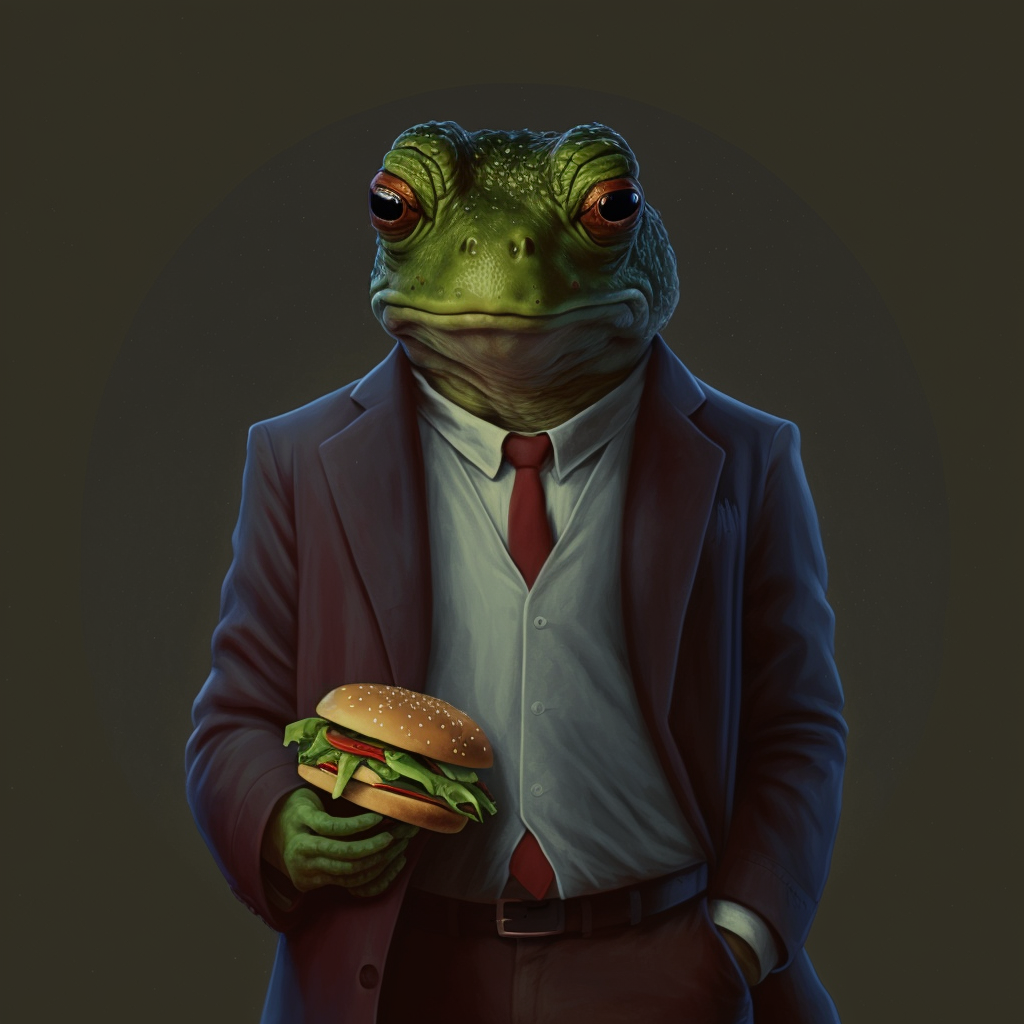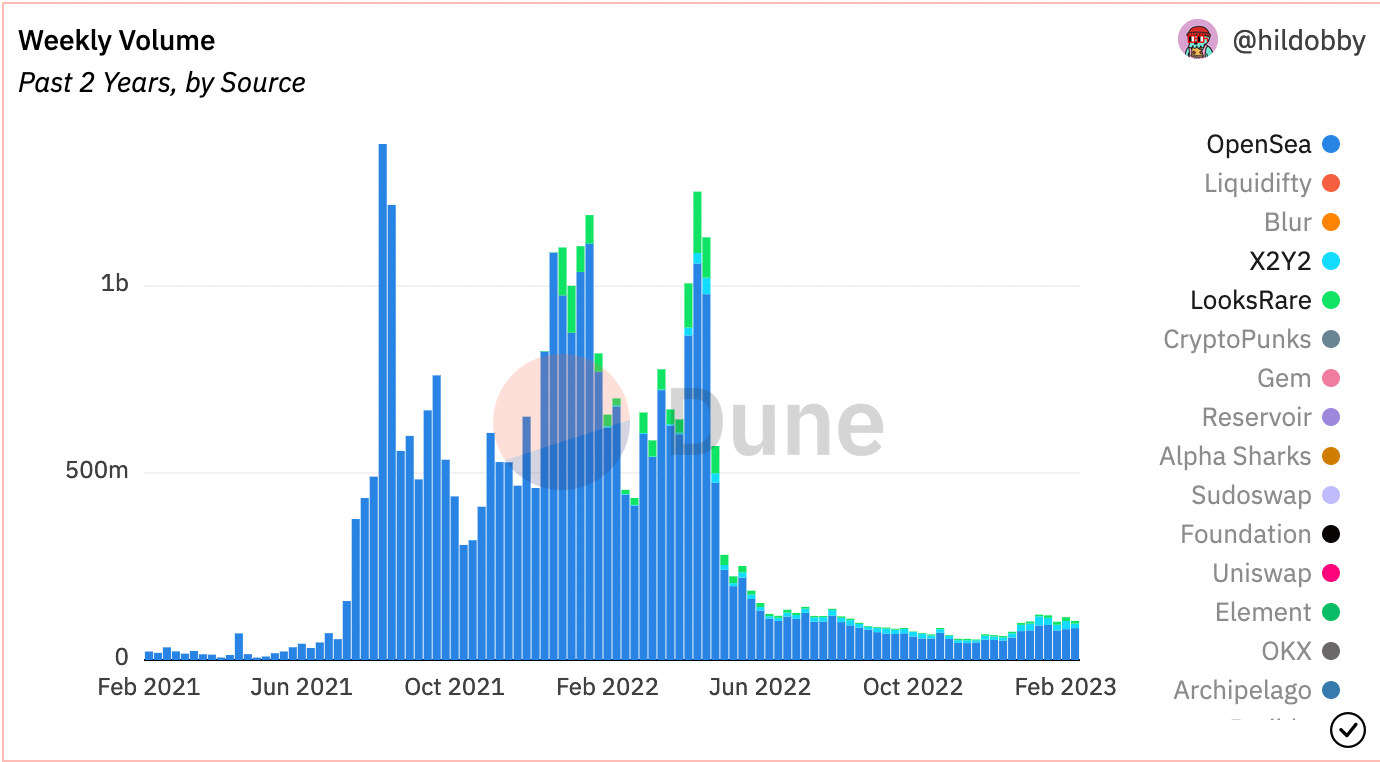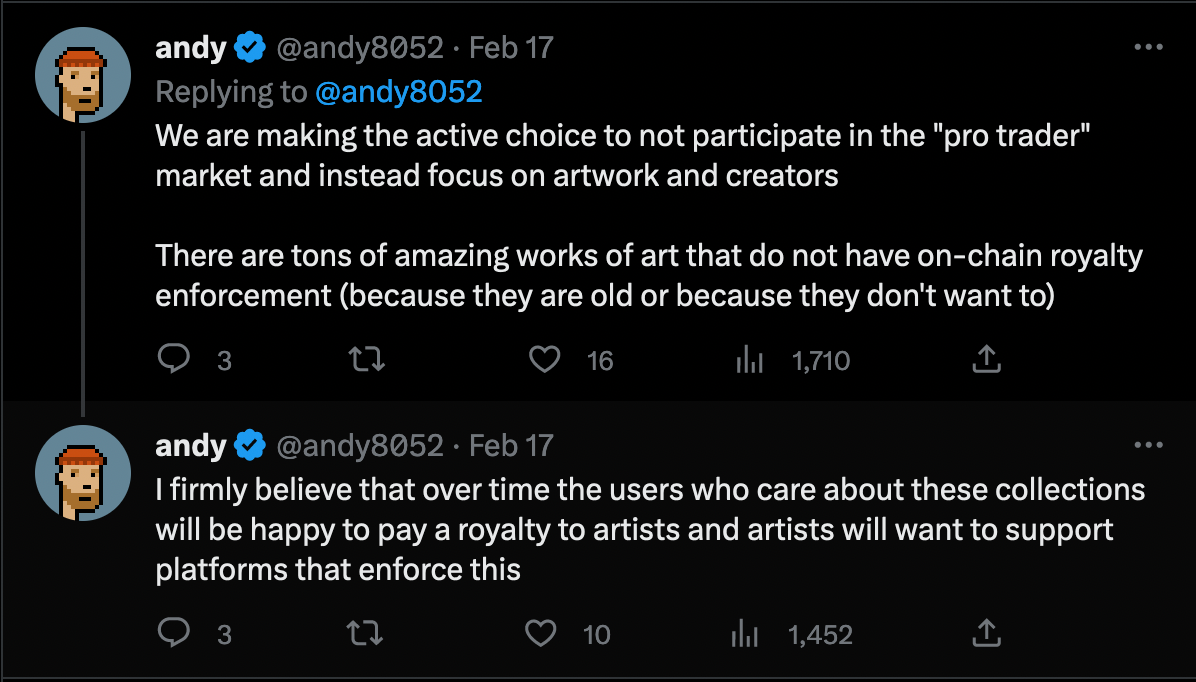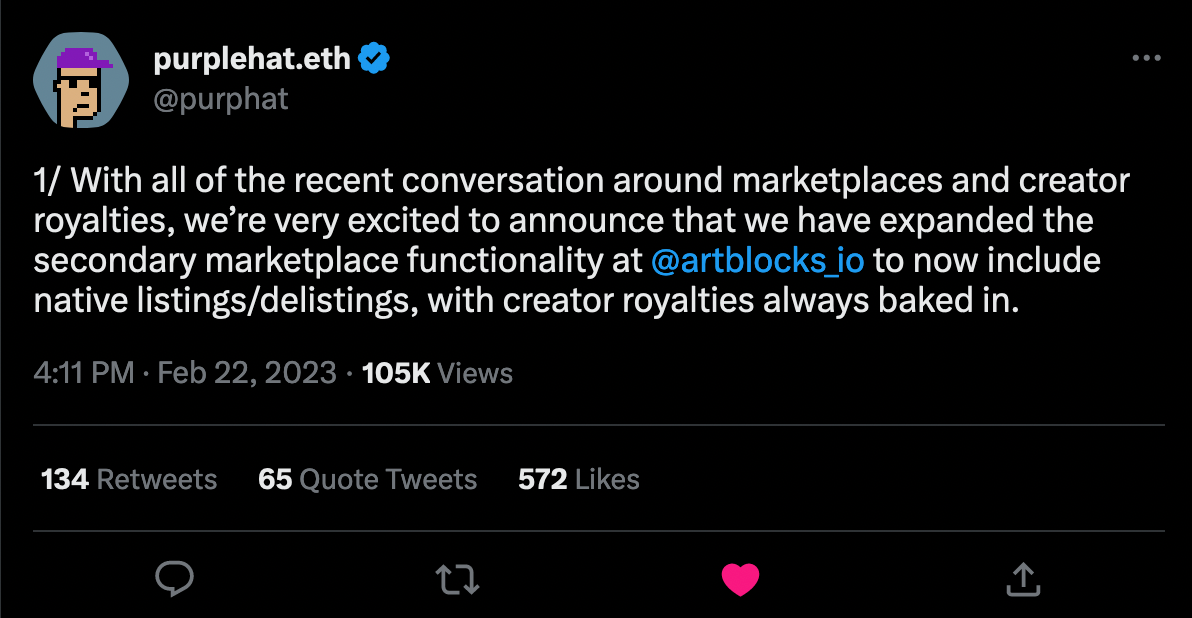Royale With Cheese
Royalties are the talk of the town. But despite the feigned shock this was always in the post.

Like many others before me I was seduced by the allure of perpetual royalties for artists and creators when I first started to dig into NFTs. Conceptually this was so simple, yet the implications were so profound. After all, why should artists and creators not continue to participate in the financial upside of their own success? NFTs and royalties seemed to open up an entirely new world of possibilities for artists, allowing many to focus full time on their practice.
Despite the early successes that royalty based revenue streams brought creators, the whole system was always balanced on a knife edge. One thing crypto has largely succeeded at is codifying certain social contracts around trust and permission and in doing so removed middlemen. Yet royalties always were a social contract and not something enforceable on chain. Considering this years ago, a race to the bottom always felt inevitable. Now that we’re here it might be interesting to look back on what happened, muse on some of the possible causes, and examine how royalties can still be an important part of the revenue strategy for creators.
What Happened?
In some ways the “what” can be boiled down to good old fashioned competition. As the NFT Summer of 2021 hit fever pitch, OpenSea (the leading NFT marketplace by a country mile) was raking in money hand over fist with a 2.5% rake on all trade volume. And it wasn’t just OpenSea that was profiting greatly — traders were as well. In an Up Only market where everyone is making money and paying fees reduces friction collectors and traders will be less price sensitive. While OTC deals and products like SudoSwap existed back then, most trades for NFTs were still going through a marketplace due to the ease of use and the liquidity. Any impact that those opting out of the royalty social contract had was minimal at best. That is until the NFT marketplace space got some much needed competition.
LooksRare entered to the scene with a pretty clear, but ultimately ineffective, value prop. The combination of a lower marketplace fee (2% vs OpenSea’s 2.5%) and the $LOOKS token airdropped to users of OpenSea seems like solid enough ideas to siphon off liquidity from OS. However the product itself shipped prematurely and despite the near uniform antipathy towards OpenSea at the time, listings on OS proved to be too sticky and LooksRare just never caught on. This didn’t stop others from trying to fight OS for market share. X2Y2 was another that cropped up with token incentives designed to pull traders away from OpenSea. Rather than a 2% marketplace fee X2Y2 cut right to the chase with 0.5%. For smaller transactions this wouldn’t make much of a difference, but for larger ones it become common to see private listings for OTC deals move over there. After all if you were making a 100ETH purchase you’d save a full 2ETH on the marketplace fees buying on X2Y2 vs OpenSea.

Looking at this chart you can see how little impact either X2Y2 or LooksRare had on OpenSea’s dominance. What is interesting about this chart is that you can pretty much see the moment that X2Y2 went nuclear and made creator royalties optional. From that moment onwards you barely see any volume on LooksRare. Another thing this chart shows very clearly is the NFT bear market. It’s no coincidence that the formal move away from the social contract of creator royalties happened once volume fell off a cliff. As more marketplaces began to compete for slices of a smaller and smaller pie it was one of the few levers left to pull. From the perspective of a trader, a 2.5–12% rake becomes a tougher pill to swallow when margins shrink and the market no longer operates on easy mode, so it’s only natural we saw platforms move in this direction.

While X2Y2’s move to not enforce royalties began to put this into the minds of some, the roaring success of Blur was what really poured gas on the fire. Blur’s marketplace was not only a material improvement in user experience it was also a masterclass in marketing and finding true product market fit. Built for traders Blur did not enforce creator royalties, but rather incentivized users to opt into them via Blur care packages (aka $BLUR tokens). This did go someway towards mitigating the impact of opt in royalties but ultimately it wasn’t an effective use of token incentives for Blur and they have since moved away from this. As the chart clearly shows Blur started to eat OpenSea’s lunch. Feeling despirate, OpenSea — the biggest NFT marketplace out there — played one of the few cards they had left and moved to stop enforcing creator royalties as well.

Just like that we’ve reached something of the inevitable end state of broken social contracts — marketplaces fighting each other for volume while those who drive the true value are overlooked.
The “Why” Of It All
On the one hand the why is pretty easy — competition for volume between marketplaces kicked of a race to the bottom in an attempt to entice traders (there’s that word again). While on the surface this is undoubtedly true I think there are a number of other factors that played a huge role in getting us to where we are now. The two I want to discuss in this piece are:
- Giving up your “brand” moat buy failing to own the point of sale
- Highest volume collections raising incredibly large venture rounds
On the brand moat stuff, I think SnowFro nails a lot of the thoughts I have had around the tension between traders and patrons in this excellent thread:

Social contracts are harder to break when participants feel a genuine connection. While leaning into marketplaces like OpenSea early made a lot of sense for many projects, artists, and creators I remain somewhat shocked that very few of these projects didn’t move to bring their marketplaces in-house sooner — Art Blocks in particular. Allowing a generic marketplace to own the point of contact (or sale) for users cheapens the experience and doesn’t imbue the interaction with a sense of brand identity or customer loyalty. When one of the core experiences and interactions that users have with a brand happens via a third party it’s easy to see how that sense of obligation to uphold a social contract wanes.
This ladders into large collections that drove much of the volume on these marketplaces making a sharp and noticeable transition from creator + community project to VC backed company. Nothing really shatters the illusion that you are not, in fact, all in this together quite like the biggest NFT brands raising enormous sums of money and them immediately treating holders like a customers rather than a community member. You can see this in projects from Yuga to Doodles to Proof, and many more. When the proverbial curtain is pulled back here it frays the edges of the social contract around royalties. Why should I give these massive brands more of my hard earned money after they just raised tens of millions of dollars while implicitly shifting the relation from creator/collector to business/customer?
As these relationships break down with so called “Blue Chip” projects the impact trickles down. If the traders who drive real volume feel that they can break the social contract, or perhaps that the other party already broke it first, then marketplaces will follow suit as they know who butters their bread. Caught in the crossfire of all this are smaller projects or individual artists who might see a reduction in important revenue streams, simply due to royalties becoming opt in and thus requiring users to play a more active role in participating. While this is ultimately bad news in the short term for many, crisis does tend to breed opportunity.
Opportunity Strikes
We’re already starting to see new marketplaces with enforced royalties catering to specific types of collectors pop up. Well before the drama of the last few weeks Tessera announced their new product Escher, a marketplace with the artist at the core not the smart contract. With Escher, Tessera is making an active choice to not cater to the trader and instead aims to put the focus squarely on the art. Escher is starting out with zero marketplace fees and will always enforce royalties to artists. While this isn’t quite what I mentioned in the previous section regarding creators owning their own point of sale I do think a product like Escher with it’s “Showroom” can help create a good facsimile of a storefront for artists, and strengthen the sense of customer loyalty and brand identity.

Taking things a step further Art Blocks announced they are entering the marketplace space themselves, adding listing & delisting functionality to the Art Blocks site with zero marketplace fee. They will additionally aggregate listings across other marketplaces and royalty adjust them for you, however buying any of those listings will still incur the marketplace fee of marketplace where the asset is listed. With this move Art Blocks will ensure that their own listings will be the cheapest place to sell work from Art Blocks collections while honoring royalties. To get the full details of this check out purplehat’s thread:

Consider, for a moment, the size of treasury that many of the top projects that drive tons of volume across generic marketplaces have raised. I expect many of them to look at what Art Blocks has done and move towards owning their own marketplace. They could even turn royalties off and just collect a 0.5% to 1% marketplace fee and arguably be better off than they are now. Furthermore, moving towards vertical marketplaces would stem the leak in value from brands and communites to faceless platforms. Yuga alone across BAYC, MAYC, BAKC, and Otherdeeds has done over 2.2 MILLION Ether in volume on OpenSea historically — with OpenSea generating 55.2k ETH in fees for themselves. That is 55.2k ETH taken out of the Yuga community and NFT ecosystem as a whole and placed on OpenSea’s balance sheet. Sure, a16z might be happy about that but I fail to see how letting OpenSea (or Blur) own the marketplace is good for Yuga collectors.
Finally, artists and creators themselves still have agency they can exercise here to try and reward participation in the royalties contract. The beauty of transparent blockchains is you sorta know what users (wallets) are doing. It wouldn’t be too difficult to track the movement of assets from wallet to wallet and build a sort of social credit model to account for those who pay artists royalties and those who don’t — tools are already in development to make this easier. Artists and creators could then reward those who adhere to the social contract with airdrops, access, or allowlisting to new mints while excluding the free loaders. By adding more jeopardy to participation in the royalty social contract creators can take back some of the control they have lost so far.
Final Thoughts
The market seems to be at a tipping point when it comes to royalties. The fact that the social contract has been broken doesn’t mean it cannot be repaired. While many are looking for solutions, not all are created equally. I am deeply distrustful of certain attempted “solutions” such as Limit Break’s proposal to effectively turn permissionless assets into web2 database entries. Am I shocked that a guy who made his money on predatory “Free 2 Play” web2 mobile games is proposing this solution? Not at all.
Ultimately I think crypto natives are too smart to fall for this kind of nonsense and a slower, more deliberate approach from artists and creators to build stronger moats around their brands by own the point of sale will play out. In doing so, I believe it is possible to rebuild broken bonds and create a meaningful relationship between the artist and the patron. There will always be flippers and profit seekers, but without strong community bonds and brand stories its much harder to turn the flippoooor into the collectoooor.
Until next time frens…
0x0x BEW
Any views expressed in the below are the personal views of the author and should not form the basis for making investment decisions, nor be construed as a recommendation or advice to engage in investment transactions. As always, please do your own research. This is not financial advice. Every strategy is not for everyone. Each investor needs to understand what is right for them.
Meet BEW, a wine collecting web developer who moonlights as an amateur chef. BEW's passion for wine is evident in his vast collection of bottles from all over the world. He also has a great interest in web development and is known for his skills in multiple programming languages such as Python, JavaScript and HTML/CSS. He is able to combine his love for wine and web development by creating visually appealing and user-friendly websites for wineries and wine shops. He is also an amateur chef and loves experimenting in the kitchen and pairing wine with his dishes. In his free time, BEW enjoys 3D glasses and the immersive experience it gives him when watching movies and playing video games.